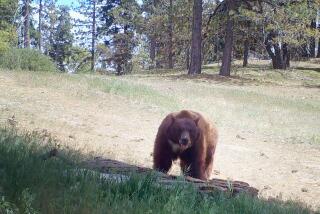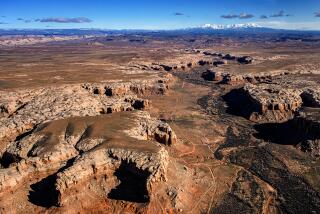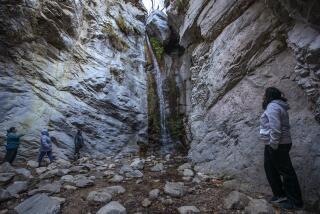Reviving debate over Bears Ears National Monument also revives racial tension in a remote corner of Utah

The debate over the best use of these vast canyonlands is not just about states’ rights or who should control public land. Nor is it only about environmental protection or the preservation of Native American culture.
It is also about the people who have lived alongside each other in this remote corner of southeastern Utah for decades — and the tension and distrust that continues to divide them.
“I don’t like to degrade it down to race, but I think a lot of this comes down to that,” said Ben Brewer, who is white and grew up in the town of Blanding. “It’s a heated issue here, for sure.”
This week, as Interior Secretary Ryan Zinke conducts a “listening tour” across the region to decide whether to reverse the designation of Bears Ears National Monument or reduce its size from the 1.35 million acres of ancestral Native American lands that President Obama set aside when he created the monument on Dec. 28, the depth and delicate nature of racial tension between many Native Americans and nonnatives has quickly become apparent.
On Sunday, Sen. Orrin G. Hatch, a Utah Republican whose persistent criticism of Obama’s designation helped prompt President Trump to order the review of Bears Ears and about two dozen other monuments nationwide, told reporters that Native Americans who had fought for years for Bears Ears may have been “manipulated” by environmental groups and do not realize the implications of a national monument designation.
“The Indians, they don’t fully understand that a lot of the things that they currently take for granted on those lands, they won’t be able to do if it’s made clearly into a monument or a wilderness,” Hatch said in Salt Lake City.

His comments were quickly condemned by statewide Native American groups, with the Utah League of Native American Voters demanding that Hatch apologize “for his blatantly racist, misinformed and condescending tone and words.”
The league noted that “tribes have sent their best and brightest attorneys, medicine people, policy researchers, anthropologist, ethnologists and economists” to work on Bears Ears.
Racial tension in the region dates at least to the end of the 19th century, when Mormon settlers spread south from Salt Lake into a region occupied by Native Americans for thousands of years.
The new arrivals transformed parts of the desert landscape into incongruous grids of paved streets and green grass, with Mormon churches usually the finest buildings in little towns like Blanding. And as they did in so many other places, the white settlers drove Native Americans from their land and insisted that many of their children learn English.
Places like Bears Ears — where ancient native populations hunted and farmed, made mud kivas in the sides of cliffs and left behind countless artifacts and burial sites — were claimed by the federal government. The area has long been controlled by the Bureau of Land Management but given limited protection.
In time, looting and vandalism grew and a shadowy market developed for trading in Indian artifacts.
Government raids on looters and traders began as early as the 1980s — it is illegal to take artifacts from public lands — and the current battle over Bears Ears has roots in the tension created both by the looting and the raids. One raid in particular startled residents and led to lingering bitterness.
In June 2009, more than 150 federal officers swept into Blanding and elsewhere, arresting more than 20 people on charges that they had traded in ancient Indian artifacts dug illegally from the seemingly endless desert canyonlands. Many of those arrested were from longtime local families, including a prominent physician who killed himself the day after officers showed up at his door. Two more suicides followed of people targeted in the investigation.
They got caught red-handed. It has been going on for eons. We couldn’t just let it go.
— Leonard Lee, board vice chairman of the nonprofit Utah Dine Bikeyah
The raid angered many whites, who cast it as a brazen example of federal overreach in a remote region they believed was best left to the oversight of its inhabitants.
Yet not everyone saw it that way. Many Native Americans believed the raids were more than justified, perhaps even a form of spiritual retribution for desecration of their land.
“They got caught red-handed. It has been going on for eons. We couldn’t just let it go,” said Leonard Lee, the vice chairman of the board of Utah Dine Bikeyah, a nonprofit led by Navajo Indians, the largest Native American group in the U.S.
Lee, whose group has focused on obtaining national monument designation for Bears Ears, spoke as he and dozens of other supporters of the cause waited for Zinke to arrive at Butler Wash Ruins overlook, a site of ancient ruins south of Blanding that is within the boundaries of the new monument. Zinke was accompanied by Utah Gov. Gary R. Herbert and Rep. Rob Bishop — both Republicans — and several county commissioners, all of whom opposed the designation.
“Welcome to Bears Ears,” a man shouted from the small crowd. “Welcome to the Native American legacy.”
In brief remarks to reporters, Zinke said that Bears Ears was “of course” worth protecting, but that the question was whether a monument designation was the proper status for all of it. He, like Hatch, suggested that a monument designation potentially could deprive Native Americans of some of their traditional uses of the area, such as collecting herbs for medicine.
Later, Ed Roberson, the state director for the Bureau of Land Management in Utah, who attended the event, clarified in an interview that monument designations do not prevent Native Americans from collecting medicinal herbs and wood but that it was not uncommon for people to believe they did.
Zinke and the group walked half a mile to the overlook, spending several minutes there talking and looking across at cliff dwellings abandoned by ancient pueblo people at least 700 years ago.
Under the terms outlined by Obama, Bears Ears National Monument is to be managed with the help of a first-of-its-kind coalition of tribal governments. Zinke spent an hour on Sunday meeting with members of that coalition and afterward said they were “smart, capable, passionate, and have a deep sense of tie to their culture and want to preserve it.”
Yet some members of the coalition complained afterward of Zinke’s tone and of the meeting’s brevity. The rest of his announced schedule for the week did not appear to include meetings with Native American leaders.
After the group of officials at Bears Ears viewed the ruins, it returned to its detail of large sport utility vehicles in the parking area, where supporters of the national monument remained.
When Cassandra Begay, a member of the Native American advocacy group PANDOS, persisted in asking Zinke whether he planned to meet again with tribal leaders, he initially ignored the question before stopping, turning toward Begay and, pointing his finger into her face, said, “Be nice. Don’t be rude.” Then he walked away.
More to Read
Start your day right
Sign up for Essential California for news, features and recommendations from the L.A. Times and beyond in your inbox six days a week.
You may occasionally receive promotional content from the Los Angeles Times.







